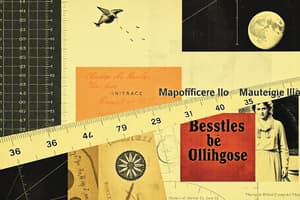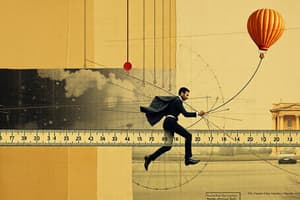Podcast
Questions and Answers
Which instrument has the finest scale for more precise measurement?
Which instrument has the finest scale for more precise measurement?
- Instrument B
- Instrument A
- Instrument D
- Instrument C (correct)
Which velocity-time graph represents an object reaching terminal velocity?
Which velocity-time graph represents an object reaching terminal velocity?
- Graph C (correct)
- Graph B
- Graph A
- Graph D
Why is Instrument C more suitable for accurate length measurements?
Why is Instrument C more suitable for accurate length measurements?
- It is longer than the others.
- It is easier to read.
- It has more subdivisions for finer measurement. (correct)
- It has larger numbers.
Which graph shows an unrealistic representation of an object falling through air?
Which graph shows an unrealistic representation of an object falling through air?
How is terminal velocity reached according to the correct graph?
How is terminal velocity reached according to the correct graph?
Flashcards are hidden until you start studying
Study Notes
Measuring Length and Motion
Measuring Length
- Instrument A has a scale with markings every 1 cm, indicating that it can measure length with an accuracy of 1 cm.
- Instrument B has a scale with markings every 1 cm, similar to Instrument A.
- Instrument C has a scale with markings every 0.5 cm, indicating that it can measure length with an accuracy of 0.5 cm.
- Instrument D has a scale with markings every 0.1 cm, indicating that it can measure length with an accuracy of 0.1 cm.
- Instrument D would give the most accurate reading due to its scale markings every 0.1 cm.
Motion and Velocity-Time Graphs
- An object falls freely through air and reaches terminal velocity before it touches the ground.
- The velocity-time graph of the object shows an initial increase in velocity, followed by a constant velocity.
- The correct velocity-time graph shows a curved line that eventually becomes horizontal, indicating terminal velocity.
- Graph A shows an initial increase in velocity, followed by a constant velocity, making it the correct graph.
- The other graphs (B, C, and D) do not show the correct velocity-time relationship for an object reaching terminal velocity.
Studying That Suits You
Use AI to generate personalized quizzes and flashcards to suit your learning preferences.




